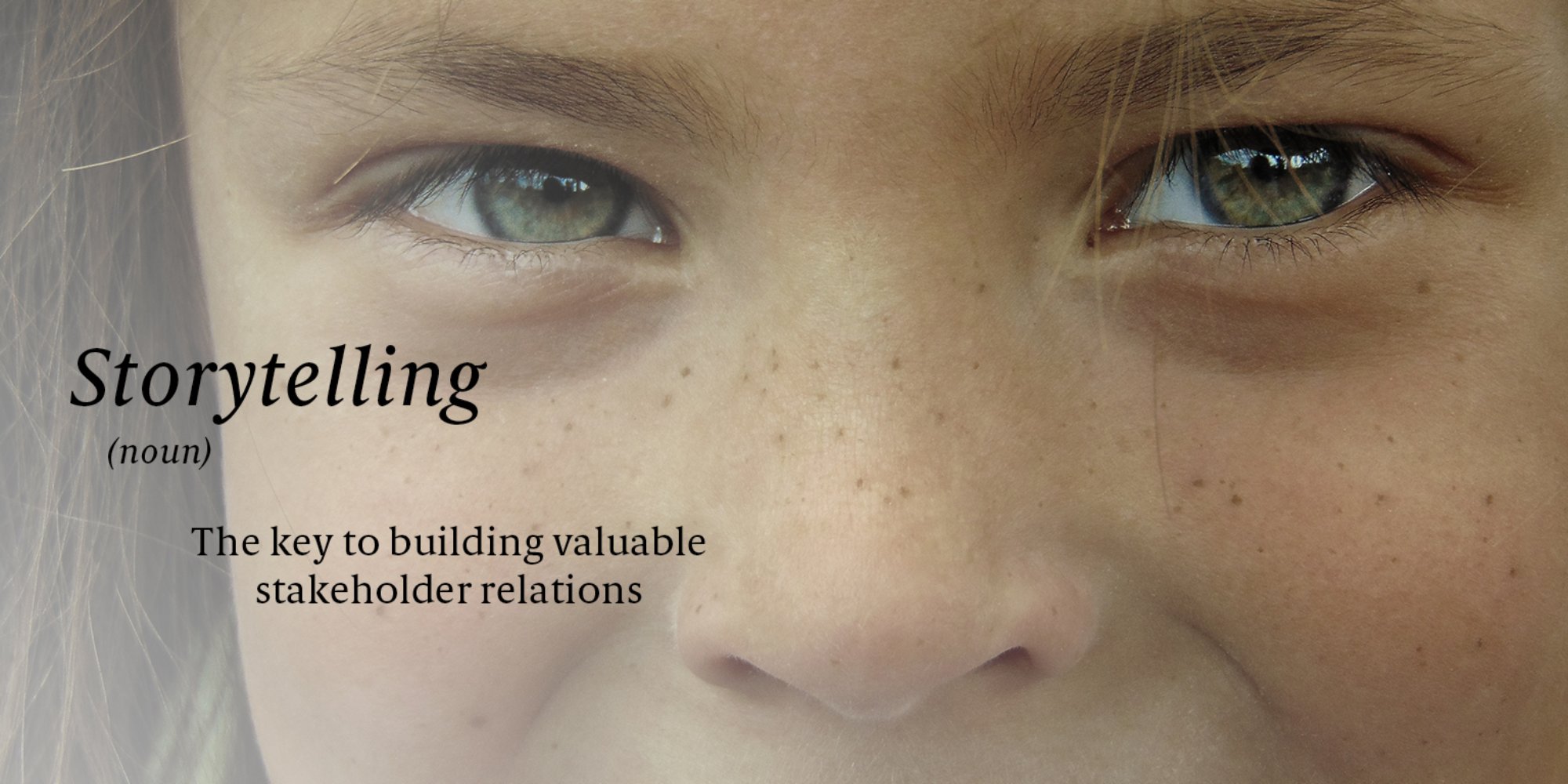
About a month ago, I experienced one of the more depressing conversations of my adult life. I had attended a conference on whatever topic I might still remember, if it weren’t for that joy-extracting encounter that became a short-term buzzkill, but also triggered my eager to bring value to a buzzword. To take the Covfefe out of storytelling.
Now, back to the conference for a second. I had just reached the end of a long inner journey to define my uniqueness in the pool of soon-to-be cand.merc.something. With the same confidence as if had just solved the question of humans existence on earth, I was more than happy to share with whoever was willing to listen to me talking about myself. And it wouldn’t take long until I had somebody on my hook.
As I stood their blabbering on about my passion for connecting brands with consumers through stories arising from an authentic brand narrative (spoiler alert), I noticed how the expression on the face of this young man, who had become a victim of my professional fantasy, started deteriorating word by word, until he interrupted me: Sorry, but I simply can not understand, how you intent to convince any employer that they can make money from telling fairytales?
Okay, maybe I had just ran into an unequalled sceptic, but none the less in my inability to provide a prompt answer, I felt defeated. Luckily, my unpreceded stubbornness has a way of not letting me accept resistance, so I spent the last month reflecting about how to approach storytelling from a more holistic and value driven perspective and explain why I see it as one of todays most efficient ways to connect with your organisation’s stakeholders.
Once upon a time…
Science has for quite some time been familiar with the correlation between a good story and increased brain activity that translates into increased attention and engagement from the audience (Weinschenk, 2014). But while great examples and metaphors that provoke sympathy, anger, fear our excitement, may be key to a succesful presentation, it does not say a lot about the power of storytelling in an organisational context or as a tool to empower brand value.
In his HBR article from 2014, Paul J. Zak provides scientific arguments for great stories’ ability to trigger empathy and willingness to cooperate (Zak, 2014). See, now it’s getting interesting. In todays consumer environment, brand loyalty is a dying breed and in the eager to meet constantly changing demands, organisations often end up loosing direction and focus on their purpose which leaves them with even less loyal customers due to inconsistent and inauthentic brand messages. But if Zak’s (2014) research holds true, storytelling might be the key to solving the problem.
Think about it, if you feel compassionate about another person wouldn’t you be more likely to trust them? Oh yes you would, cause you are human like the rest of us. And we all know that mutual trust is the foundation for healthy collaboration. Rather B2C or B2B, organisations are build on human-to-human interactions and collaboration, so the biological rule still counts. So, we have established that storytelling can create a stronger connection and trust between the organisation and the consumer, but I don’t think I’ve managed to convince my dear sceptic friend quite yet. Everything still seems a bit fluffy and quite unfeasible.
Strategic storytelling
In order to capitalize on these so called fairytales, organisations must first establish a solid foundation upon which every story in whatever format on whatever platform can take shape. In our story, this foundation takes physical form as the main character – translated into business terminology, your company’s why.
No matter what new adventures or challenges our main character face, he remains the same throughout the story, chapter for chapter. He interpret his surroundings based on the environment that shaped him in the past and he makes his choices from a certain set of morals and values deeply rooted within his mindset. As oppose to our story, many organisations end up with a main character who loose himself along the way in an attempt to grab any opportunity out there.
Before you can derive value from storytelling, you must build an authentic main character by defining a clear why. However, the journey doesn’t stop there. A why may be well defined and enacted within the organisation, but we still need a good story to spark the empathy and cooperation trigger. Use the same technices as fictional writers to build a story around the characteristics of your main character – define a clear plot, use figurative language, create an emotional dynamic and personalize your brand. The only true rule is to let your main character guide the development and each chapter in the story you choose to tell.
Consider this example from Airbnb: https://www.youtube.com/watch?v=_bwus2cIbNA and how it relates to this: https://www.youtube.com/watch?v=BpAdyFdE3-c and to this: ‘Creating a sense of belonging, anywhere in the world’ (Airbnb, 2017). The two stories are clear offsprings of the same why despite the very different design, feel and mood between the two. Same main character. Same novel. Different chapters. What you end up with is a compelling brand narrative that builds authenticity as it scales.
A new headline for each chapter
If storytelling makes communication more valuable and instigate a desire to collaborate in the mind of the receiver, then why not write a chapter for each part of your business where you need stakeholders to ‘collaborate’.
- Employer brand Talent attraction has become a complex size which resemble the political arena. Companies fight to gain the attention of young bright minds which often result in unrealistic and over-glorified promises. They may buy-on on your story, but if you fail to deliver, they drop like flies. However, when done right storytelling can be the key to an improved retention rate among your youngest pool of employees. The generation that enters your organisation as we speak are driven by purpose and the desire to create something greater than a positive bottomline. (#Youngster, 2017) Use a chapter of your book to describe the visionary future for your main character and how your future employees are a vital enabler for that vision to become reality. Don’t be afraid of being ambitious, as long as structures, culture and tasks reflect the vision.
- Customer relations To say that brand loyalty is a dying breed might even be an understatement. The combination of endless access to information and the instability and complexity of todays social environment, has caused an almost exponential growth in the variables that affect our buying behaviour and perception of brands. But as humans we do not act out of rationality. We act from emotional stimuli and the more involved we are in the created experience that intent to spark a certain action from us as consumers, the more declined we are to collaborate. Storytelling is a great tool to include the customer in your brand experience because it speaks to our emotions and not our rationality. The more attached we feel to someone, the more likely we are to trust and make decisions that accommodate the relation. So for this chapter, I suggest giving your main character a partner in crime. Guess who.
- Internal branding Customer, future- or current employees, we are always dealing with the human brain, so giving people an important role in your story goes for all stakeholder groups. This chapter is all about engaging your employees in the story and empower them to build the suspense as your story grows. Enabling your employees to become ambassadors is a powerfull way to build authenticity around your brand externally. As a manager you allow your employees to take autonomy and build mutual trust. A visionary internal chapter may also prove a life-saver when your culture becomes vicim of company succes.
Key takeaways
1. Storytelling is a powerfull tool to connect with a wide range of stakeholders.
2. Your story is the creative and personalised interpretation of your why. Use the same techniques as fiction writers to enable the emotional stimuli that triggers empathy and allows you to influence the actions of your target group.
3. Think of how you can expand on your core story to fit the desire and wishes of different stakeholder interests.
4. And if someone tells you, you can’t make money on your passion, proof them otherwise.
References:
Weinschenk, S. (2014) Your Brain On Stories. Retrieved from: https://www.blog.theteamw.com/2014/11/04/your-brain-on-stories/
Zak, J. P. (2014) Why Your Brain Loves Good Storytelling. Harvard Business Review. Retrieved from: https://hbr.org/2014/10/why-your-brain-loves-good-storytelling
YoungConsult (2017) #Youngster.

